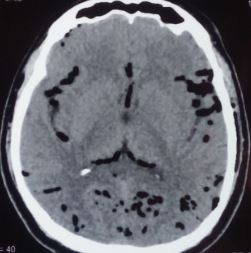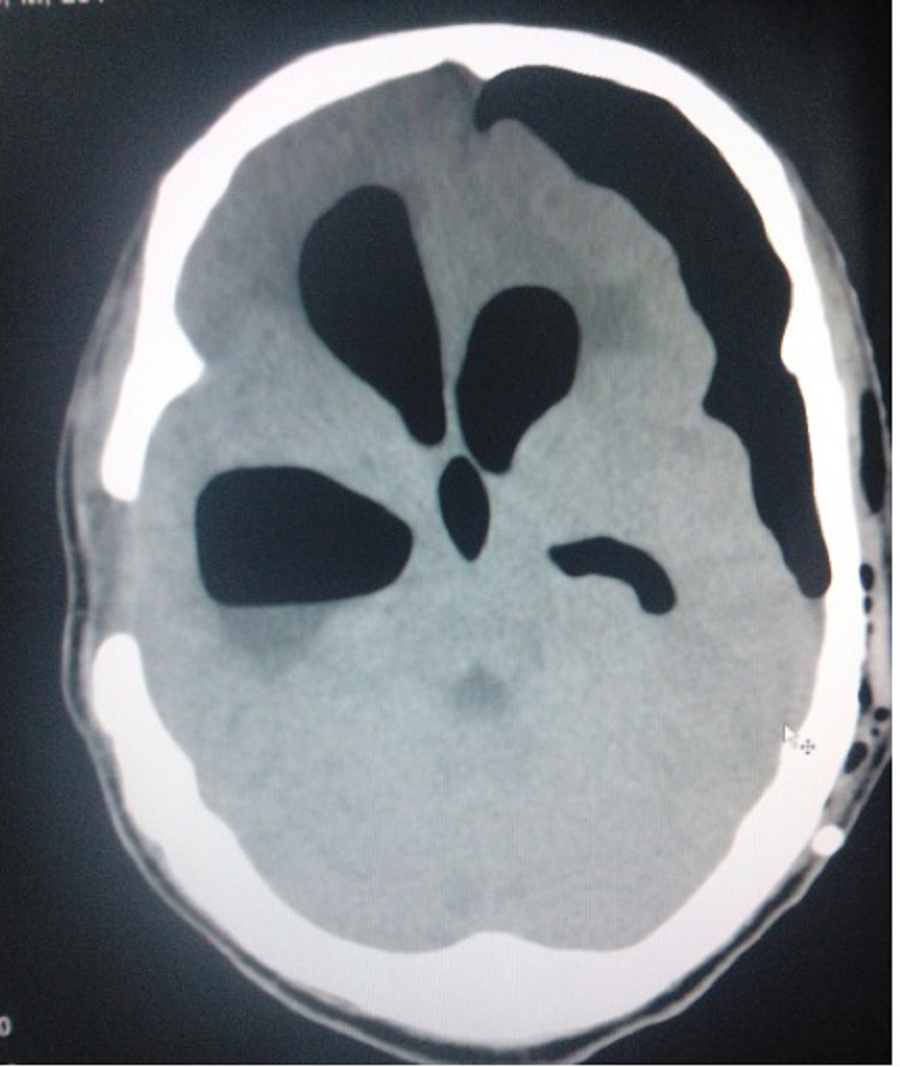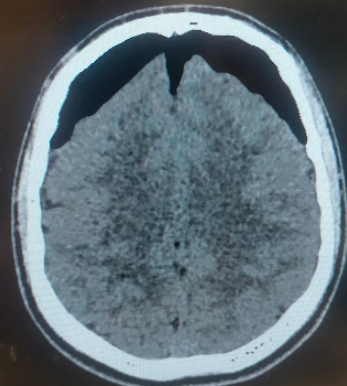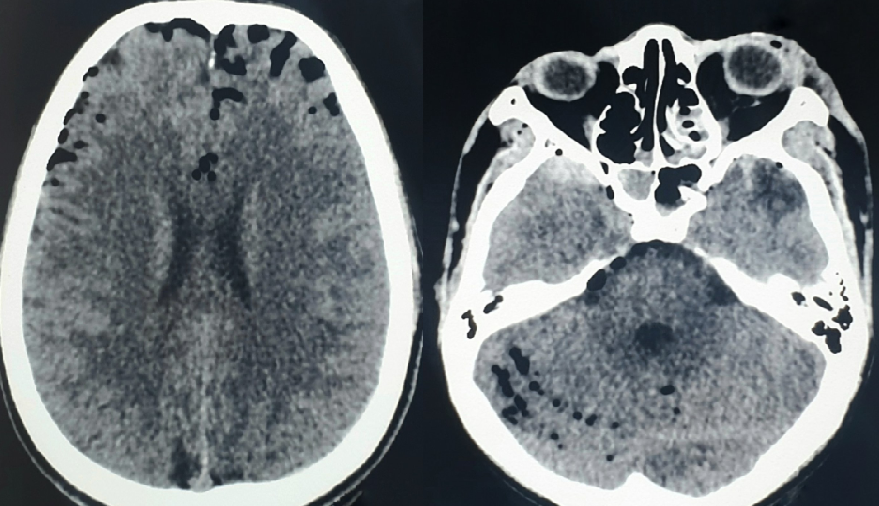[1]
Álvarez-Holzapfel MJ, Aibar Durán JÁ, Brió Sanagustin S, de Quintana-Schmidt C. [Diffuse pneumocephalus after lumbar stab wound]. Anales de pediatria. 2019 Jan:90(1):63-64. doi: 10.1016/j.anpedi.2018.04.012. Epub 2018 Jun 11
[PubMed PMID: 29903638]
[2]
Yates H, Hamill M, Borel CO, Toung TJ. Incidence and perioperative management of tension pneumocephalus following craniofacial resection. Journal of neurosurgical anesthesiology. 1994 Jan:6(1):15-20
[PubMed PMID: 8298259]
[4]
Schirmer CM, Heilman CB, Bhardwaj A. Pneumocephalus: case illustrations and review. Neurocritical care. 2010 Aug:13(1):152-8. doi: 10.1007/s12028-010-9363-0. Epub
[PubMed PMID: 20405340]
Level 3 (low-level) evidence
[5]
Kankane VK, Jaiswal G, Gupta TK. Posttraumatic delayed tension pneumocephalus: Rare case with review of literature. Asian journal of neurosurgery. 2016 Oct-Dec:11(4):343-347
[PubMed PMID: 27695534]
Level 3 (low-level) evidence
[6]
Wankhade BS, Beniamein MMK, Alrais ZF, Mathew JI, Alrais GZ. What should an intensivist know about pneumocephalus and tension pneumocephalus? Acute and critical care. 2023 May:38(2):244-248. doi: 10.4266/acc.2021.01102. Epub 2022 Apr 13
[PubMed PMID: 35545242]
[7]
Pillai P, Sharma R, MacKenzie L, Reilly EF, Beery PR 2nd, Papadimos TJ, Stawicki SP. Traumatic tension pneumocephalus - Two cases and comprehensive review of literature. International journal of critical illness and injury science. 2017 Jan-Mar:7(1):58-64. doi: 10.4103/IJCIIS.IJCIIS_8_17. Epub
[PubMed PMID: 28382259]
Level 3 (low-level) evidence
[8]
Awad A, Al-Ali A, Ahmad A, Al-Abdullah H. A suprasellar Aerocele as a Complication of Endoscopic Transsphenoidal Surgery: A Case Report. Ear, nose, & throat journal. 2024 Sep 17:():1455613241276767. doi: 10.1177/01455613241276767. Epub 2024 Sep 17
[PubMed PMID: 39286913]
Level 3 (low-level) evidence
[9]
Śmiłowska K, Sznajder-Stacha K, Kocyłowski D, Popek A, Rozpondek K, Grechuta M, Salari M. Pneumocephalus as a rare complication: a systematic review plus clinical vignette. Neurologia i neurochirurgia polska. 2021:55(3):253-268. doi: 10.5603/PJNNS.a2021.0014. Epub 2021 Feb 5
[PubMed PMID: 33543469]
Level 1 (high-level) evidence
[10]
Burkhardt E, Savardekar A, Sin A. Traumatic Subarachnoid-Pleural Fistula with Pneumocephalus. World neurosurgery. 2022 Nov:167():229-229.e3. doi: 10.1016/j.wneu.2022.07.080. Epub 2022 Jul 30
[PubMed PMID: 35917920]
[11]
Mamani-Rodriguez CE, Goyo Pinto JA, Soler C. [Ventricular and cisternal pneumocephalus secondary to open periorbital trauma]. Medicina. 2024:84(5):1032
[PubMed PMID: 39399954]
[12]
Brandvold B, Lee D, Garcon J. Tension Pneumocephalus Caused by a Communicating Pneumothorax via a Nerve Root Avulsion. Cureus. 2024 Aug:16(8):e67317. doi: 10.7759/cureus.67317. Epub 2024 Aug 20
[PubMed PMID: 39301331]
[13]
Brueske B, He C, Chauhan V. Devastating Neurological Outcome Following a Subarachnoid-Pleural Fistula During Thoracic Surgery. Cureus. 2024 Apr:16(4):e57838. doi: 10.7759/cureus.57838. Epub 2024 Apr 8
[PubMed PMID: 38721223]
[14]
McCarthy S, Villarreal N, Sailor M. Acute Streptococcus pneumoniae Meningitis: A Case Report. AACN advanced critical care. 2024 Sep 15:35(3):244-250. doi: 10.4037/aacnacc2024820. Epub
[PubMed PMID: 39213628]
Level 3 (low-level) evidence
[15]
Grewal N, Hager K, Pinelo AC, Duddukunta Y, Tolla GG, Gasmelseed H. Unique Presentation of a Ubiquitous Organism: Capnocytophaga canimorsus Meningitis With Pneumocephalus. Cureus. 2024 May:16(5):e59529. doi: 10.7759/cureus.59529. Epub 2024 May 2
[PubMed PMID: 38826958]
[16]
Yesilyurt M, Dostbil A, Sakci Z, Ince I, Ogul H. Postpartum intraventricular pneumocephalus following epidural anaesthesia. British journal of hospital medicine (London, England : 2005). 2021 May 2:82(5):1. doi: 10.12968/hmed.2020.0566. Epub 2021 May 3
[PubMed PMID: 34076523]
[17]
Lee J, Lee DC. Delayed unilateral pneumocephalus after bilateral endoscopic dacryocystorhinostomy in an elderly patient. BMJ case reports. 2021 May 25:14(5):. doi: 10.1136/bcr-2020-241540. Epub 2021 May 25
[PubMed PMID: 34035023]
Level 3 (low-level) evidence
[18]
Alharbi A, Khairy S, Alkhani A. Pneumocephalus after subcutaneous emphysema. Surgical neurology international. 2022:13():249. doi: 10.25259/SNI_994_2021. Epub 2022 Jun 17
[PubMed PMID: 35855157]
[19]
Luo L, Tang L, Tan M, Fu W. Intracranial air following spinal anesthesia: A case report. Zhong nan da xue xue bao. Yi xue ban = Journal of Central South University. Medical sciences. 2024 Jun 28:49(6):998-1004. doi: 10.11817/j.issn.1672-7347.2024.230511. Epub
[PubMed PMID: 39311796]
Level 3 (low-level) evidence
[20]
Zhang K, Jia H. Simultaneous gas embolism and pneumocephalus after paravertebral irrigation with hydrogen peroxide: A rare case report. International journal of surgery case reports. 2024 Mar:116():109387. doi: 10.1016/j.ijscr.2024.109387. Epub 2024 Feb 15
[PubMed PMID: 38367418]
Level 3 (low-level) evidence
[22]
Aaron KA, Eltawil Y, Fernandez-Miranda JC, Jackler RK. Spontaneous Otogenic Pneumocephalus Triggered by Air Travel. Otology & neurotology : official publication of the American Otological Society, American Neurotology Society [and] European Academy of Otology and Neurotology. 2024 Jan 1:45(1):e68-e70. doi: 10.1097/MAO.0000000000004054. Epub
[PubMed PMID: 38085769]
[23]
Tankersley A, Khan S, Estes K, Paisley C. Non-surgical resolution of pneumocephalus following a sneeze. BMJ case reports. 2024 Sep 25:17(9):. doi: 10.1136/bcr-2024-261096. Epub 2024 Sep 25
[PubMed PMID: 39322573]
Level 3 (low-level) evidence
[24]
Lopez L, Hauber J, Wyler B. Spontaneous pneumocephalus on the fastest elevator in North America: a case report. CJEM. 2022 Aug:24(5):547-549. doi: 10.1007/s43678-022-00316-x. Epub 2022 May 11
[PubMed PMID: 35543925]
Level 3 (low-level) evidence
[26]
Steudel WI, Hacker H. Prognosis, incidence and management of acute traumatic intracranial pneumocephalus. A retrospective analysis of 49 cases. Acta neurochirurgica. 1986:80(3-4):93-9
[PubMed PMID: 3716896]
Level 2 (mid-level) evidence
[27]
Clevens RA, Marentette LJ, Esclamado RM, Wolf GT, Ross DA. Incidence and management of tension pneumocephalus after anterior craniofacial resection: case reports and review of the literature. Otolaryngology--head and neck surgery : official journal of American Academy of Otolaryngology-Head and Neck Surgery. 1999 Apr:120(4):579-83
[PubMed PMID: 10187965]
Level 3 (low-level) evidence
[28]
Sweni S, Senthilkumaran S, Balamurugan N, Thirumalaikolundusubramanian P. Tension pneumocephalus: a case report with review of literature. Emergency radiology. 2013 Dec:20(6):573-8. doi: 10.1007/s10140-013-1135-7. Epub 2013 Jun 11
[PubMed PMID: 23748929]
Level 3 (low-level) evidence
[29]
Martinez-Nunez AE, Wong JK, Hilliard JD, Foote KD, Okun MS. Preventing Shift from Pneumocephalus During Deep Brain Stimulation Surgery: Don't Give Up the 'Fork in the Brain'. Tremor and other hyperkinetic movements (New York, N.Y.). 2024:14():18. doi: 10.5334/tohm.873. Epub 2024 Apr 10
[PubMed PMID: 38617832]
[30]
Cunqueiro A, Scheinfeld MH. Causes of pneumocephalus and when to be concerned about it. Emergency radiology. 2018 Aug:25(4):331-340. doi: 10.1007/s10140-018-1595-x. Epub 2018 Mar 15
[PubMed PMID: 29546674]
[31]
Leong KM, Vijayananthan A, Sia SF, Waran V. Pneumocephalus: an uncommon finding in trauma. The Medical journal of Malaysia. 2008 Aug:63(3):256-8
[PubMed PMID: 19248704]
[32]
Omer GL, Maurizi R, Velletrani G, Francavilla B, Ali SS, Abdullah AS, Di Girolamo S. Traumatic tension pneumocephalus: a case report and perspective from Indonesia. Frontiers in neurology. 2024:15():1391270. doi: 10.3389/fneur.2024.1391270. Epub 2024 May 3
[PubMed PMID: 38765266]
Level 3 (low-level) evidence
[33]
Munakomi S, Bhattarai B, Sah SB. Flapping Scalp Sign as a Rare and Interesting Presentation in Delayed Postoperative Tension Pneumocephalus. JAMA neurology. 2021 Jul 1:78(7):874-875. doi: 10.1001/jamaneurol.2021.1149. Epub
[PubMed PMID: 33970209]
[34]
Ikeda R, Kikuchi T, Sato S, Oshima H, Kawamura Y, Kusano Y, Kawase T, Katori Y, Kobayashi T. Pulsatile tinnitus caused by pneumocephalus after Janneta surgery. Auris, nasus, larynx. 2021 Aug:48(4):793-796. doi: 10.1016/j.anl.2020.05.024. Epub 2020 Jun 22
[PubMed PMID: 32586740]
[35]
Karavelioglu E, Eser O, Haktanir A. Pneumocephalus and pneumorrhachis after spinal surgery: case report and review of the literature. Neurologia medico-chirurgica. 2014:54(5):405-7
[PubMed PMID: 24305016]
Level 3 (low-level) evidence
[36]
Ishiwata Y, Fujitsu K, Sekino T, Fujino H, Kubokura T, Tsubone K, Kuwabara T. Subdural tension pneumocephalus following surgery for chronic subdural hematoma. Journal of neurosurgery. 1988 Jan:68(1):58-61
[PubMed PMID: 3335913]
[37]
Castedo J, Ferreira AP, Camacho Ó. Hyperbaric oxygen therapy in the treatment of pneumocephalus associated with epidural block: case report. Brazilian journal of anesthesiology (Elsevier). 2021 May-Jun:71(3):295-298. doi: 10.1016/j.bjane.2021.02.058. Epub 2021 May 3
[PubMed PMID: 33957186]
Level 3 (low-level) evidence
[38]
Dexter F, Reasoner DK. Theoretical assessment of normobaric oxygen therapy to treat pneumocephalus. Anesthesiology. 1996 Feb:84(2):442-7
[PubMed PMID: 8602677]
[39]
Kim BJH, Ji MY, Chen JCC, Correia JA, Law AJJ, Kow CY. Use of oxygen therapy for pneumocephalus: a systematic review. Neurosurgical review. 2024 Jan 4:47(1):30. doi: 10.1007/s10143-023-02261-4. Epub 2024 Jan 4
[PubMed PMID: 38172487]
Level 1 (high-level) evidence
[40]
Harvey JJ, Harvey SC, Belli A. Tension pneumocephalus: the neurosurgical emergency equivalent of tension pneumothorax. BJR case reports. 2016:2(2):20150127. doi: 10.1259/bjrcr.20150127. Epub 2016 May 8
[PubMed PMID: 30363668]
Level 3 (low-level) evidence
[41]
Arbit E, Shah J, Bedford R, Carlon G. Tension pneumocephalus: treatment with controlled decompression via a closed water-seal drainage system. Case report. Journal of neurosurgery. 1991 Jan:74(1):139-42
[PubMed PMID: 1984495]
Level 3 (low-level) evidence
[42]
Doron O, Schneider JR, Ellis JA. Application of the subdural evacuating port system for the drainage of postoperative tension pneumocephalus: A technical note. Surgical neurology international. 2022:13():204. doi: 10.25259/SNI_120_2022. Epub 2022 May 20
[PubMed PMID: 35673650]
[43]
Ji KSY, Rimmer R, Dogan A, Cetas JS, Ciporen JN, Sanusi O, Gupta S, Geltzeiler M. Endoscopic Endonasal Eustachian Tube Obliteration as a Treatment for Tension Pneumocephalus After Translabyrinthine Resection of Vestibular Schwannoma. Otology & neurotology : official publication of the American Otological Society, American Neurotology Society [and] European Academy of Otology and Neurotology. 2022 Sep 1:43(8):e856-e860. doi: 10.1097/MAO.0000000000003606. Epub
[PubMed PMID: 35970161]
[44]
Moran-Guerrero JA, Martínez HR, Gonzalez-Sanchez DG, Perez-Martinez LE, Flores-Salcido RE, Ferrigno AS, Caro-Osorio E, Salazar-Alejo M, Avalos-Montes PJ, Figueroa-Sanchez JA. Backup Frontal Drainage System for Urgent Tension Pneumocephalus Management After Chronic Subdural Hematoma Surgery: A Retrospective Cohort Study. World neurosurgery. 2024 Aug:188():68-75. doi: 10.1016/j.wneu.2024.04.138. Epub 2024 Apr 29
[PubMed PMID: 38692567]
Level 2 (mid-level) evidence
[45]
Aljabali A, Serag I, Diab S, Alhadeethi AZ, Abdelhady M, Alkhawaldeh IM, Abouzid M. Irrigation versus no irrigation in the treatment of chronic subdural hematoma: An updated systematic review and meta-analysis of 1581 patients. Neurosurgical review. 2024 Mar 28:47(1):130. doi: 10.1007/s10143-024-02368-2. Epub 2024 Mar 28
[PubMed PMID: 38538863]
Level 1 (high-level) evidence
[46]
Fujimoto A, Hatano K, Nozaki T, Sato K, Enoki H, Okanishi T. Postoperative Pneumocephalus on Computed Tomography Might Predict Post-Corpus Callosotomy Chemical Meningitis. Brain sciences. 2021 May 15:11(5):. doi: 10.3390/brainsci11050638. Epub 2021 May 15
[PubMed PMID: 34063350]
[47]
Mignucci-Jiménez G, Matos-Cruz AJ, Abramov I, Hanalioglu S, Kovacs MS, Preul MC, Feliciano-Valls CE. Puerto Rico Recurrence Scale: Predicting chronic subdural hematoma recurrence risk after initial surgical drainage. Surgical neurology international. 2022:13():230. doi: 10.25259/SNI_240_2022. Epub 2022 Jun 3
[PubMed PMID: 35855136]
[48]
Umekawa M, Hasegawa H, Shinya Y, Shin M, Saito N. Incidence of and risk factors for chronic subdural hematoma after endoscopic endonasal surgery: quantitative analysis of pneumocephalus. Journal of neurosurgery. 2024 Aug 1:141(2):484-490. doi: 10.3171/2024.1.JNS231953. Epub 2024 Mar 8
[PubMed PMID: 38457806]
[49]
Zhang DY, Pearce JJ, Petrosyan E, Borghei A, Byrne RW, Sani S. Minimizing pneumocephalus during deep brain stimulation surgery. Clinical neurology and neurosurgery. 2024 Mar:238():108174. doi: 10.1016/j.clineuro.2024.108174. Epub 2024 Feb 16
[PubMed PMID: 38422743]
[50]
Domino KB, Hemstad JR, Lam AM, Laohaprasit V, Mayberg TA, Harrison SD, Grady MS, Winn HR. Effect of nitrous oxide on intracranial pressure after cranial-dural closure in patients undergoing craniotomy. Anesthesiology. 1992 Sep:77(3):421-5
[PubMed PMID: 1519779]
[51]
Eftekhar B, Ghodsi M, Nejat F, Ketabchi E, Esmaeeli B. Prophylactic administration of ceftriaxone for the prevention of meningitis after traumatic pneumocephalus: results of a clinical trial. Journal of neurosurgery. 2004 Nov:101(5):757-61
[PubMed PMID: 15540912]
[52]
Huh J. Barotrauma-induced pneumocephalus experienced by a high risk patient after commercial air travel. Journal of Korean Neurosurgical Society. 2013 Aug:54(2):142-4. doi: 10.3340/jkns.2013.54.2.142. Epub 2013 Aug 31
[PubMed PMID: 24175032]
[53]
Lim E, Lan BL, Ooi EH, Low HL. Pneumocephalus and air travel: an experimental investigation on the effects of aircraft cabin pressure on intracranial pressure. Scientific reports. 2020 Aug 12:10(1):13626. doi: 10.1038/s41598-020-70614-w. Epub 2020 Aug 12
[PubMed PMID: 32788610]
[54]
Bichsel O, Hauck A, Oertel M. Air travel with pneumocephalus: a systematic review. Acta neurochirurgica. 2022 Sep:164(9):2395-2400. doi: 10.1007/s00701-022-05297-5. Epub 2022 Jul 6
[PubMed PMID: 35794427]
Level 1 (high-level) evidence
[55]
Amato-Watkins A, Rao VM, Leach P. Air travel after intracranial surgery: a survey of advice given to patients by consultant neurosurgeons in the UK. British journal of neurosurgery. 2013 Feb:27(1):9-11. doi: 10.3109/02688697.2012.716176. Epub 2012 Aug 30
[PubMed PMID: 22931355]
Level 3 (low-level) evidence



